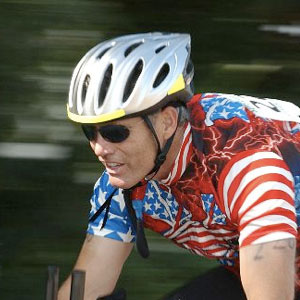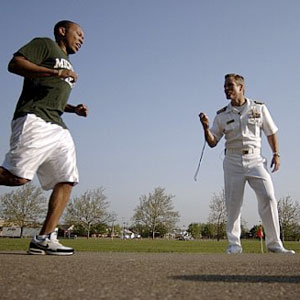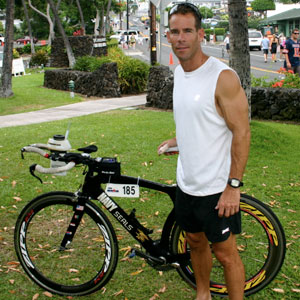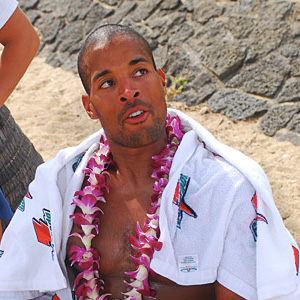A talk with Captain Duncan Smith

Captain Duncan Smith joined the US Navy SEALs in 1985, and transferred to Naval Reserve to attend graduate school in the early '90s. He returned to active duty with the SEAL teams in the weeks following September 11, 2001. Since that time he has deployed to Iraq, Afghanistan and the Horn of Africa. Most recently he headed up the Naval Special Warfare Recruiting Directorate. As a competitive adventure racer during the 90’s, Smith competed in the ‘96 Eco Challenge (part of that year's ESPN X-Games), the '97 Southern Traverse of New Zealand and was on the top finishing American team in the 1997 Raid Gauloise. During that time he completed his MBA from UCLA's Anderson School and worked as an investment banker before he combined his experience as a SEAL and his background in adventure racing to start up the Presidio Adventure Racing Academy. Presido was the world's first adventure racing training institute. His corporate clients included Deloitte Consulting, Stanford Business School, the FBI, and Oracle and Jian Software. As of late, Smith has been instrumental in garnering media attention for SEALs at high profile events including the X-Games and Ironman Hawaii as well as continuing to lead the nationwide Navy SEAL Fitness Challenge.
Captain Smith spent time with slowtwitch to discuss the logistics that went into the jump, what a successful SEAL candidate might look like, and why triathlon and other endurance sporting events produce potential SEAL candidates.
Slowtwitch: What kind of boat were we in during the jump in Kailua Bay?
DS: We were in a rigid, inflatable boat or RIB. To keep costs low, we rented civilian boats in the Kona area instead of bringing SEALs and Navy RIBs in at a much, much greater cost to the taxpayer. Boats were arranged for in August and were a part of planning meetings, our rehearsal jump and racer practice movement.
ST: What roles did the two Navy SEALs in the boat have in the coordination between the boat and the C-130 aircraft during the jump?
DS: Chief J.C. Ledbetter was the leading Chief Petty Officer from the Navy Parachute Team. He was the Drop Zone Officer on the day of the jump. His role included ensuring the drop zone was safe by monitoring sea state and wind chop. Additionally, he ensured that all civilian boat traffic remained clear of the drop zone. He communicated with the air crew and Jumpmasters by radio and by visual signals. For visual, recovery boats must be on line for the Jumpmaster to send parachutists off the airplane's ramp.
Master Chief Paul Tharp coordinated logistics for the recovery and placement of the SEALs at the start line after their parachute jump.

ST: What were those guys (David Goggins and Keith Davids) thinking about up there?
DS: They were busy from 03:30 in the morning getting set for the jump and the Ironman. Once airborne aboard the the C-130 both SEALs were reviewing parachuting procedures as they received their 10-minute, 6-minute and 2-minute warnings from the Jumpmaster. There are many unique procedures that go along with completing a water jump. As jumpers leave the aircraft, the first thing we need to do is make sure we are lined up on the target area or drop zone and that we are reading the wind right. Next, we remove our reserve parachutes when we are in the air. Getting rid of the reserve and unfastening our chest strap is vital in order to remove our main parachute once we hit the water. Even the best swimmer in Kona would eventually get dragged under if harnessed to a military parachute filled with thousands of pounds of water.
ST: How did the timing of this jump compare to an operational jump?
DS: It totally depends on the mission. There could be missions where you exit the plane at today's low altitude. Typically you go in, free-fall and with combat equipment, so you would be more in the 12,500-ft range or much higher with oxygen equipment, but that is something that I can't talk too much more about.
ST: What was your role out there?
DS: I was the Marlin Perkins of this group. I've been at this event three years now. I'm a Captain and am 50 years old. In my mind this is about the guys competing in the Ironman, but the other part of it is being able to take part in all the things we are asked to do on a regular basis as SEALs. In my mind, I need to take part in every evolution a SEAL-in-training is required to do. Also I'm responsible for filming Davids and Goggins from the air, so I jumped with a helmet camera on. It's a beautiful opportunity to take part in this event.
The last few times I've been out here my role has been managerial, which requires working with race director Diane Bertsch and her team. Together we build the vision to make sure people have what they need to make our athletes' race successful. At the same time, I'm a team guy – a SEAL – and want to get my knees in the breeze as much as anyone. That's why I was happy to parachute today.

ST: Is it unique to the SEALs or common across the board in the military for instructors to get out there and do the same training as the trainees?
DS: I think it's something prized by the military as a whole. If you're a Navy pilot, you're still doing your qualifications whether you're a Lieutenant or a Captain or you're in the Air Force, Marine Corps or Army. But, in the Special Operations community, in the SEAL teams in particular, you've got to deliver the goods. When we have guys who graduate from SEAL training, the officers and enlisted at the Naval Special Warfare Center do a PT evolution with the newest SEALs.
It's lead-by-the-front and we give them a run for their money. Typically there is some young kid who was a college athlete that's winning. I know that Keith Davids has been the first person across that line at graduation PT when he was Director of Training.
ST: What kind of competitive athletes do you see come through training?
DS: We see athletes like collegiate swimmers, wrestlers and members of club triathlon teams. We see collegiate football players who shift their focus to preparing for Basic Underwater Demolition/SEAL (BUD/S) training. Whether you're a swimmer or a football player you have to do SEAL-specific conditioning to be successful in BUD/S. While you don't need to be an Olympic athlete at any element of SEAL training, you need to be above average at everything. There are some unbelievable athletes who don't graduate SEAL training because there is an important mental component. Pass at the basic minimums in any category and you won't have the additional bandwidth to face the mental hurdles which I believe are greater than any physical challenges – a strong mind has the ability to drive through adversity and work as a teammate. This is very much a solo sport in many ways but we also need to know that our candidates are willing to work with six other team members in pitch black, with eight-foot surf and a rubber boat, and you have to be able to work together.
ST: How are SEALs in the water?
DS: A good high school swimmer will beat most SEALs in a 50-meter sprint. That all changes when you strap a limpet mine to their back or ask them to swim the combat sidestroke for four miles.

ST: The Navy SEALs have focused recruiting efforts on the endurance sporting market in the last few years and you have been leading that campaign. Has this been successful?
DS: We try to carefully track our recruiting successes from water polo tournaments, triathlons, mountain bike races, X-Games and other events. There are different ways to do that but it's not a perfect science. Also we have to be very careful at how we handle personal information. Even in the Navy there are plenty of skeptics who don't buy into the notion of placing a priority on educating athletes on the opportunity to serve as a SEAL. I can share one clear data point with you about Ironman. Two years ago, a journalist was out here asking about the SEALs on behalf of her brother and cousin. They were from Colorado and heard little about the program. Fast forward to today and her cousin is now about to graduate from SEAL training. He was a high school athlete, an Eagle Scout, and a big wall climber. A tough, fit kid with a track record of determination and success. He was going to achieve great things at whatever he chose. Again, his exposure to us before 2006 Ironman was zero. Our campaign to reach athletes and those who influence athletes is putting people into the Navy who have become successful SEALs.
Our metrics need to be improved but the proof is that since this program began, our pass rate on the SEAL screening test at boot camp has gone from 28 percent in March 2005 to over 90 percent today. The same test is taken by EOD Techs, Divers, Special Warfare Combatant Crewmen and SEALs. The SEALs have the highest passing standard. In 2005, before we had begun reaching out to athletes, we had never in our history filled a class at BUD/S. Three years later we have filled multiple classes, back to back. And it's interesting to note that the highest pass rate in BUD/S among any athletes is
triathletes who graduate from training at nearly twice the average rate.
ST: Does the Navy have plans to continue recruiting efforts in the endurance-sports market?
DS: Yes, the Navy is emphasizing fitness for all their personnel and for the general public. Take a look at navyathletes.com, a website that comes online in late November. Along with attracting the right candidates to serve in the more physically demanding roles of SEAL, SWCC, EOD and Diver, the Navy is setting an example of fitness for all its members.
ST: What other events are coming up? Triathlon, mountain bike, SEALs Fitness
Challenge, etc?
DS: The Navy SEAL athlete program is ongoing. In addition to the Ultra Runs, triathlons, wrestling camps and mountain bike events that SEALs are participating in, the Navy SEAL Fitness Challenge travels across the United States testing male and female athletes to the SEAL standard. We have more details on that at our website: www.sealfitnesschallenge.com.






Start the discussion at forum.slowtwitch.com